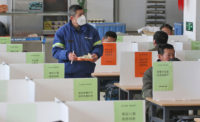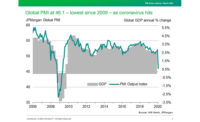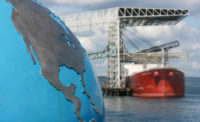Fears related to the new coronavirus, or COVID-19, continue to grow in the U.S. and across the world, and with that comes economic uncertainty.
The future is “cloudy at best,” says Richard Branch, chief economist at Dodge Data & Analytics. Branch says that there is likely to be a recession in the second quarter of the year, possibly into the third, with effects on future construction starts still unclear. The Dodge Data & Analytics first quarter 2020 forecast predicts a 3% decline from 2019’s level, which Branch now calls “too optimistic.”
A Bright Spot
“The good news is that construction starts began the year with a decent amount of wind in its sails with starts in January and February generally above the levels seen in early 2019,” says Branch. “Many of the building trends seen in 2019 have carried over to this year.”
Branch points to several large projects that have broken ground since the beginning of the year, such as the $383-million Richard Gilder Center for Science in New York, a $124-million Amazon warehouse facility in Memphis and a $766-million hospital project in Paramus, N.J.
“Usually I would not look to the first two months of a year to determine a pattern. However, given recent circumstances it is reassuring that prior to the events of the last week that construction starts activity was on reasonably solid ground,” he says.
|
Related Link |
Supply and Demand
Alex Carrick, chief economist at ConstructConnect, notes that in addition to worries regarding COVID-19, oil prices have also dropped due to the increased production in Saudi Arabia.
Ordinarily, that could be good for some parts of the economy. “But cheaper gasoline is nice only if you have someplace to go,” he adds, alluding to the increasing shuttering of malls, restaurants and other public places in order to contain spread of the coronavirus.
On the supply side, “the last week or so has been characterized by hoarding and stockpiling. With store shelves beginning to run empty, this trend must soon run its course,” says Carrick. “Will there be a similar phenomenon with respect to construction activity? Probably. [Contractors with current projects will] need the materials and labor to see their work through to completion. Plus, with factory closings around the world, assured sources of some building components will be drying up.”
On the demand side, he says, the largest effect will come from projects being placed on hold.
Branch agrees. “[Projects] may see delays in start, or longer times to completion based on shortages of supplies from China or a reduction in available labor due to spread of the virus. Still others, such as hotels, may begin to see jobs canceled outright due to a sudden circumstantial change in demand.”
Carrick also touched on the March 15 decision by the Federal Reserve to cut interest rates to 0%-0.25%, a drastic reduction. “I suspect the Fed may be using all the arrows in its quiver too quickly. Now there’s little more the Fed can do to provide stimulus further along,” he says, adding that “nothing says panicking like 0% interest rates.”
Price Drop
IHS Markit’s most recent forecast was published at the end of February, before the effects of COVID-19 began to grow in the U.S. John Mothersole, director of research for IHS Markit, reports that commodity prices as measured by the Materials Price Index (MPI) are now projected to drop by more than 20% year over year in the second quarter. That will constitute a 10% drop from what was projected a month ago.
“The reaction in commodity markets clearly shows that the loss in aggregate demand is significant and offsets any disruptions to supply,” says Mothersole. “In addition, the scale of the shock means that a rebound will be “U” not “V” shaped, with a recovery likely stretching beyond the third quarter.”
IHS Markit foresees a bottom in the second quarter, but expects slow recovery for the next six quarters. “Price levels even at the end of next year are still projected to be lower than their first quarter 2020 average,” says Mothersole. “The risk clearly leans to the downside.”






Post a comment to this article
Report Abusive Comment